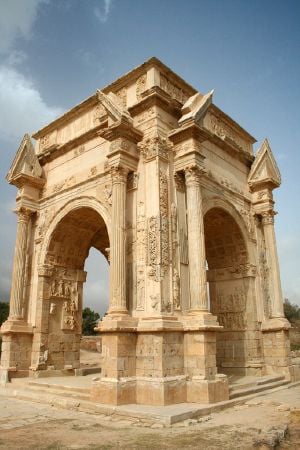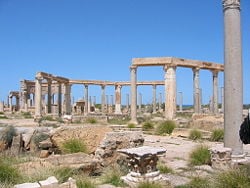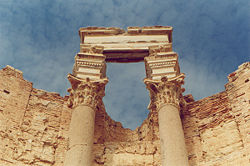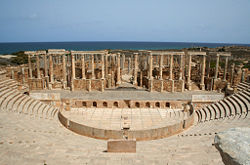Leptis Magna
| Archaeological Site of Leptis Magna* | |
|---|---|
| UNESCO World Heritage Site | |

| |
| State Party | 22px Libyan Arab Jamahiriya |
| Type | Cultural |
| Criteria | i, ii, iii |
| Reference | 183 |
| Region** | Arab States |
| Inscription history | |
| Inscription | 1982 (6th Session) |
| * Name as inscribed on World Heritage List. ** Region as classified by UNESCO. | |
Leptis Magna, also known as Lectis Magna (or Lepcis Magna as it is sometimes spelled), also called Lpqy or Neapolis, was a prominent city of the Roman Empire. Its ruins are located in Al Khums, Libya, 130 km east of Tripoli.
The city appears to have been founded by Phoenician colonists sometime around 1100 B.C.E., although it did not achieve prominence until Carthage became a major power in the Mediterranean Sea in the 4th century B.C.E. It nominally remained part of Carthage's dominions until the end of the Third Punic War in 146 B.C.E., and then became part of the Roman Republic, although from about 200 B.C.E. onward it was for all intents and purposes an independent city.
Leptis Magna remained as such until the reign of the Roman emperor Tiberius, when the city and the surrounding area were formally incorporated into the empire as part of the province of Africa. It soon became one of the leading cities of Roman Africa and a major trading post.
Leptis achieved its greatest prominence beginning in 193, when a native son, Lucius Septimius Severus, became emperor. He favored his hometown above all other provincial cities, and the buildings and wealth he lavished on it made Leptis Magna the third most-important city in Africa, rivaling Carthage and Alexandria. In 205, he and the imperial family visited the city and received great honors.
During the Crisis of the Third Century, when trade declined precipitously, Leptis Magna's importance also fell into a decline, and by the middle of the fourth century, large parts of the city had been abandoned. It enjoyed a minor renaissance beginning in the reign of the emperor Theodosius I.
In 439, Leptis Magna and the rest of the cities of Tripolitania fell under the control of the Vandals when their king, Gaiseric, captured Carthage from the Romans and made it his capital. Unfortunately for the future of Leptis Magna, Gaiseric ordered the city's walls demolished so as to dissuade its people from rebelling against Vandal rule. But the people of Leptis and the Vandals both paid a heavy price for this in 523, when a group of Berber raiders sacked the city.
Belisarius recaptured Leptis Magna in the name of Rome 10 years later, and in 534 he destroyed the kingdom of the Vandals. Leptis became a provincial capital of the Eastern Roman Empire (see Byzantine Empire), but never recovered from the destruction wreaked upon it by the Berbers. By the time of the Arab conquest of Tripolitania in the 650s, the city was abandoned except for a Byzantine garrison force.
Today, the site of Leptis Magna is the site of some of the most impressive ruins of the Roman period.
New discoveries
In June 2005 it was revealed that archaeologists from the University of Hamburg had been working along the coast of Libya when they uncovered a 30 ft length of five colorful mosaics created during the 1st or 2nd century. The mosaics show with exceptional clarity depictions of a warrior in combat with a deer, four young men wrestling a wild bull to the ground, and a gladiator resting in a state of fatigue, staring at his slain opponent. The mosaics decorated the walls of a cold plunge pool in a bath house within a Roman villa at Wadi Lebda in Leptis Magna. The gladiator mosaic is noted by scholars as one of the finest examples of representational mosaic art ever seen — a "masterpiece comparable in quality with the Alexander mosaic in Pompeii." The mosaics were originally discovered in 2000, but were kept secret to avoid looting. They are currently on display in the Leptis Magna Museum.[1]
ReferencesISBN links support NWE through referral fees
- ↑ Alberge, Dalya, (June 13, 2005), "Roman Mosaic 'Worthy of Botticelli'", The Times Online, Accessed Sep 9 2006
- Richard Talbert, Barrington Atlas of the Greek and Roman World, (ISBN 0-691-03169-X), p. 35.
External links
- LeptisMagna.com, local information, authored by Libyans
- Comprehensive website, by an archaeologist working on the site
ar:لبدة الكبرى ca:Leptis Magna de:Leptis Magna es:Leptis Magna fr:Leptis Magna id:Leptis Magna it:Leptis Magna he:לפטיס מגנה nl:Leptis Magna ja:レプティス・マグナ no:Leptis Magna pl:Leptis Magna pt:Leptis Magna ru:Лептис-Магна fi:Leptis Magna sv:Leptis Magna tr:Leptis Magna zh:大莱普提斯
Credits
New World Encyclopedia writers and editors rewrote and completed the Wikipedia article in accordance with New World Encyclopedia standards. This article abides by terms of the Creative Commons CC-by-sa 3.0 License (CC-by-sa), which may be used and disseminated with proper attribution. Credit is due under the terms of this license that can reference both the New World Encyclopedia contributors and the selfless volunteer contributors of the Wikimedia Foundation. To cite this article click here for a list of acceptable citing formats.The history of earlier contributions by wikipedians is accessible to researchers here:
The history of this article since it was imported to New World Encyclopedia:
Note: Some restrictions may apply to use of individual images which are separately licensed.



